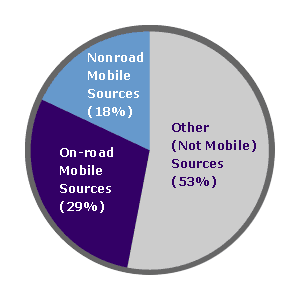Hydrocarbons
1999 National Emissions by Source: Hydrocarbons
 Hydrocarbons are a precursor to ground-level ozone, a serious air pollutant in cities across the United States. A key component of smog, ground-level ozone is formed by reactions involving hydrocarbons and nitrogen oxides in the presence of sunlight. Hydrocarbon emissions result from incomplete fuel combustion and from fuel evaporation. Today's cars are equipped with emission controls designed to reduce both exhaust and evaporative hydrocarbon emissions.
Hydrocarbons are a precursor to ground-level ozone, a serious air pollutant in cities across the United States. A key component of smog, ground-level ozone is formed by reactions involving hydrocarbons and nitrogen oxides in the presence of sunlight. Hydrocarbon emissions result from incomplete fuel combustion and from fuel evaporation. Today's cars are equipped with emission controls designed to reduce both exhaust and evaporative hydrocarbon emissions.
Click on a mobile source category for detailed information.
General information about other (not mobile) sources can be found at www.epa.gov/air/data/netdb.html and at www.epa.gov/air/urbanair/6poll.html
View the entire 1999 Trends Report for detailed information on hydrocarbon emissions by various sources.
Ground-level ozone causes health problems such as difficulty breathing, lung damage, and reduced cardiovascular functioning. A number of hydrocarbons are also considered toxic, meaning they can cause cancer or other health problems.
Learn more about the role hydrocarbons play in creating ozone, the health and environmental effects of ozone, and about hydrocarbon levels where you live.
1999 National Emissions by Source: Hydrocarbons
On-Road Mobile Sources

1999 National Emissions by Source: Hydrocarbons
Nonroad Mobile Sources

![[logo] US EPA](https://webarchive.library.unt.edu/eot2008/20081108023803im_/http://www.epa.gov/epafiles/images/logo_epaseal.gif)